be quiet! Dark Power Pro 11 850W Power Supply Review
Why you can trust Tom's Hardware
Transient Response Tests
Advanced Transient Response Tests
For details on our transient response testing, please click here.
In these tests, we monitor the response of the PSU in two different scenarios. First, a transient load (10A at +12V, 5A at 5V, 5A at 3.3V and 0.5A at 5VSB) is applied to the PSU for 200ms while the PSU is working at 20-percent load. In the second scenario, the PSU is hit by the same transient load while operating at 50-percent load. In both tests, we use our oscilloscope to measure the voltage drops caused by the transient load. The voltages should remain within the ATX specification's regulation limits.
These tests are crucial since they simulate transient loads a PSU is likely to handle (such as booting a RAID array or an instant 100-percent load of CPU/GPUs). We call these tests "Advanced Transient Response Tests," and they are designed to be very tough to master, especially for a PSU with a capacity below 500W.
20 Percent
| Voltage | Before | After | Change | Pass/Fail |
|---|---|---|---|---|
| 12V | 12.108V | 12.010V | 0.81% | Pass |
| 5V | 5.059V | 4.944V | 2.27% | Pass |
| 3.3V | 3.314V | 3.188V | 3.80% | Pass |
| 5VSB | 5.083V | 5.047V | 0.71% | Pass |
50 Percent
| Voltage | Before | After | Change | Pass/Fail |
|---|---|---|---|---|
| 12V | 12.081V | 12.006V | 0.62% | Pass |
| 5V | 5.035V | 4.929V | 2.11% | Pass |
| 3.3V | 3.294V | 3.172V | 3.70% | Pass |
| 5VSB | 5.048V | 4.998V | 0.99% | Pass |
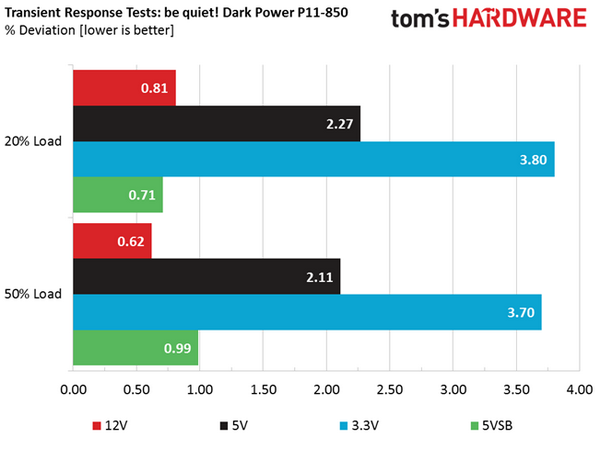
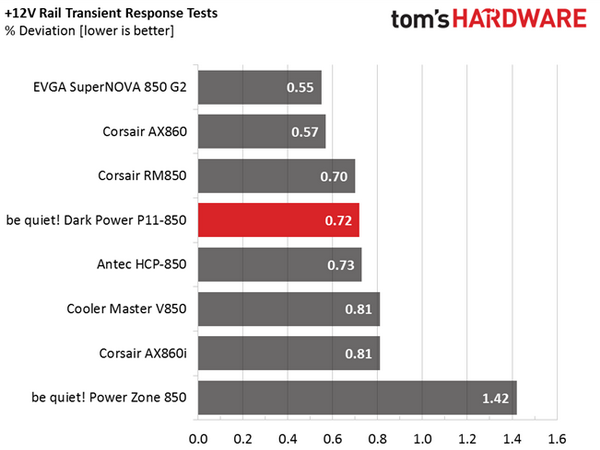
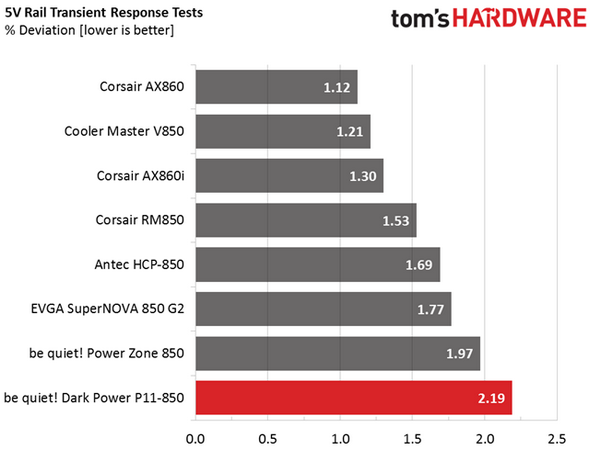
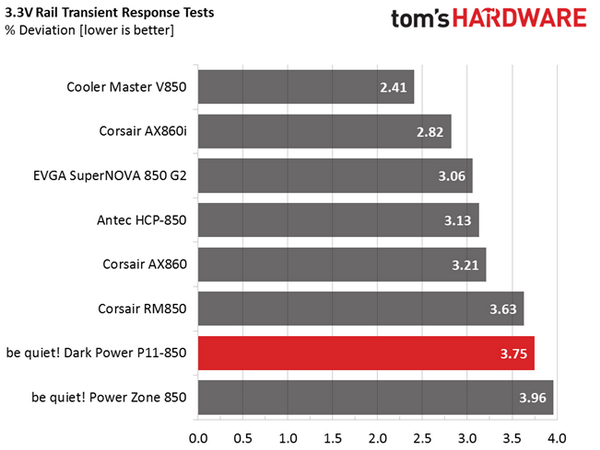
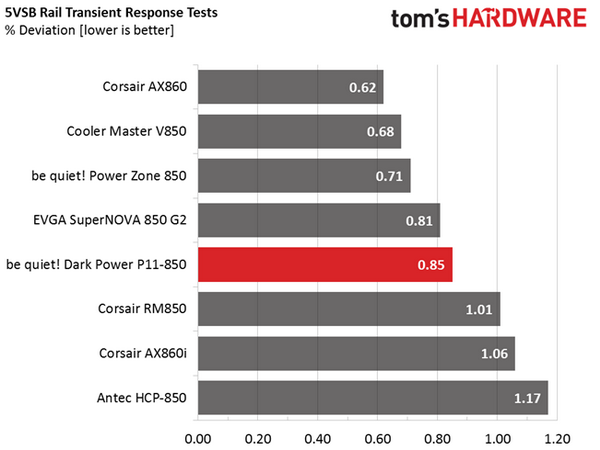
On the +12V rail, the deviations were low in both tests. But we would like to see better results on the 5V and 3.3V rails. Finally, at 5VSB the results were good enough since the average deviation was within one percent.
Below are the oscilloscope screenshots we took during Advanced Transient Response Testing.
Transient Response At 20-Percent Load

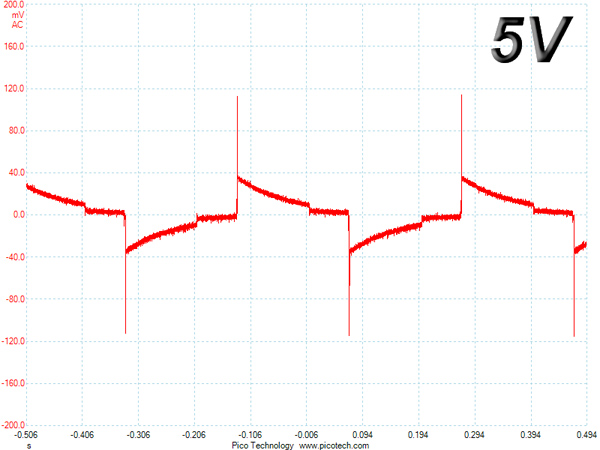
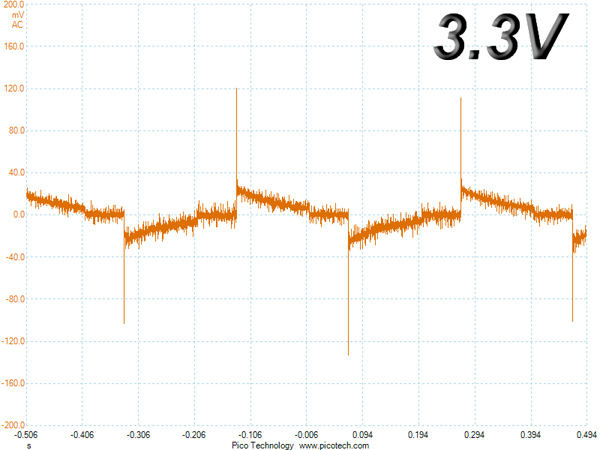

Transient Response At 50-Percent Load
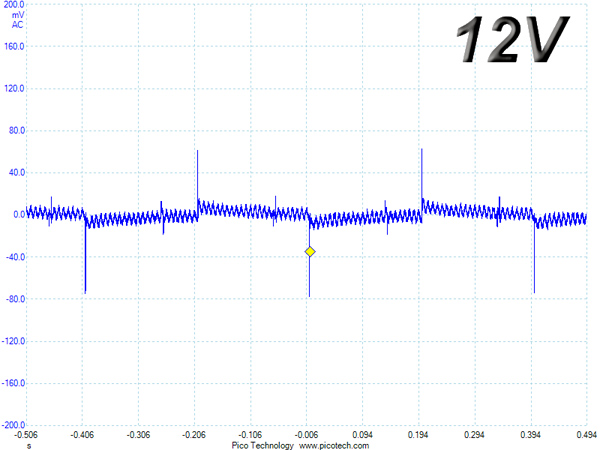
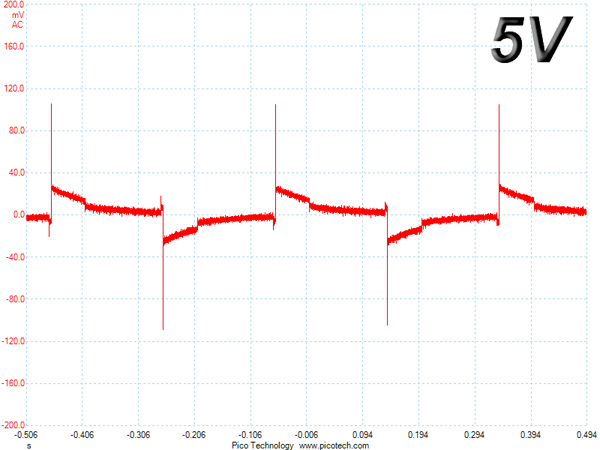

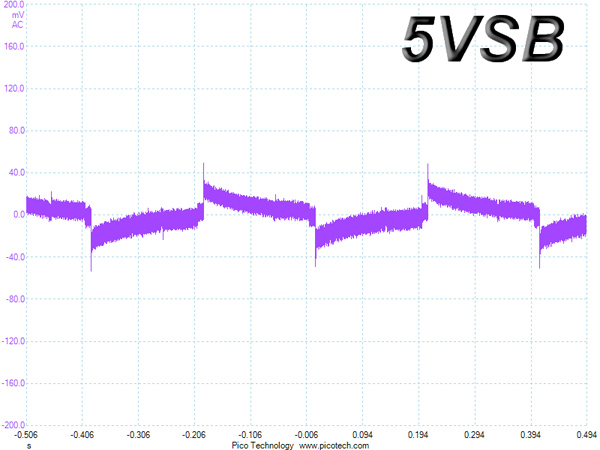
Turn-On Transient Tests
We measure the response of the PSU in simpler scenarios of transient load—during the power-on phase of the PSU—in the next set of tests.
For the first measurement, we turn the PSU off, dial the maximum current the 5VSB can output and then switch on the PSU. In the second test, we dial the maximum load +12V can handle and start the PSU while it's in standby mode. In the last test, while the PSU is completely switched off (we cut off the power or switch the PSU off by flipping the on/off switch), we dial the maximum load the +12V rail can handle before switching the PSU on from the loader and restoring power. The ATX specification states that recorded spikes on all rails should not exceed 10 percent of their nominal values (+10% for 12V is 13.2V and 5.5V for 5V).
Get Tom's Hardware's best news and in-depth reviews, straight to your inbox.



Pretty smooth slopes on all three turn-on tests. We noticed only some minor spikes after the voltage settle down to +12V; these are nothing to worry about.
Current page: Transient Response Tests
Prev Page Cross-Load Tests And Infrared Images Next Page Ripple Measurements
Aris Mpitziopoulos is a contributing editor at Tom's Hardware, covering PSUs.
-
Xivilain For lower wattage units, I'd be interested in seeing fanless designs. But it doesn't seem like BeQuiet! is targeting that market, which is sad, because there are lots of HTPC builders out there demanding silence in their living rooms. Anyawy, great review!Reply -
Aris_Mp fanless designs target a very specific market segment mostly because of their increased cost. From the moment you can have inaudible operation at light-mid loads with a proper designed, normal PSU I would highly prefer it especially since it can deliver more power when needed (but with the fan spinning at high enough speeds), than a passive one which will be restricted at 550 - 600 W tops.Reply -
Shankovich ReplyFor lower wattage units, I'd be interested in seeing fanless designs. But it doesn't seem like BeQuiet! is targeting that market, which is sad, because there are lots of HTPC builders out there demanding silence in their living rooms. Anyawy, great review!
I don't see why you cannot have a lower powered unit at 80PG and have the fan run at a low speed. I got a HX750i because I need to give a FirePro W9100 very stable power, but the principle is the same: fan turns on at some higher wattage usage (for me it's 300, but for 80PG I'd say 200 is safer). Even when the fan turns on, can't hear it at all (it has a test button).
If someone makes a 600W PSU that has this kind of fan profile, that would be a score. It won't technically be fanless quite, but the fans won't even get past 15dB for average user power usage, and around 20dB at max settings. Why all this? Will lower the price since a lower efficiency can be used. -
Giannis Karagiannis Since you can have the fan spinning at very low rpm or not at all during light and normal use I can't see a point in having a fanless PSU. During heavy loads, when you need more than 300 watts of power, I believe the noise from the PSU fan would the last thing that would be annoying you.The heat produced be the rest of the system components would be so much that you would need active cooling anywayReply
Another very comprehensive review. Keep up the good work! I would also like to see more reviews for power supplies in the sub-100$ price range. -
dudmont "The prices of the 850, 1000 and 1200W units in the U.S. are $200, $240 and $280, respectively." Yikes!Reply
I'm not convinced that a quieter PSU is where it's at. It's cooling fans that create the big noise, not the PSU and it's fan.
-
Aris_Mp be quiet! informed me that this design/platform was actually designed by one of their engineers and not by FSP, which only helped them build it through their production facilities (since be quiet! doesn't have a PSU manufacturing line).Reply
So in other words be quiet! didn't just bought this platform from FSP but they designed it on their own and FSP just produced it for them.
Until now I wasn't aware of it but now that I am, I wanted to make things right and provide the proper credit to be quiet's engineer that designed this platform (whose name is unknown to me).